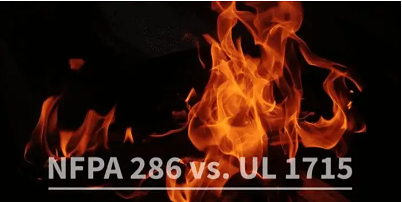NFPA 286 and UL 1715: What's The Difference?
In the world of material testing, there are many tests which seem to be identical or very similar. Room corner tests are no different in this regard. For example, many blur the line between NFPA 286 and UL 1715 referring to them as identical when, in fact, they are quite different in the methodology and examination of the results. NFPA 286 and UL 1715: What's The Difference? Tel: +86 25 86583475


Allow us to make some observations for you:
NFPA 286 is a life safety test and widely known as the defacto room corner test (also referred to as the interior finish test or 286 or Appendix X, etc.). The room itself is constructed as specified by the standard but in general incorporates an eight (8) foot by twelve (12) foot room, drywall lined stud walls and joist ceilings with the cavities full-filled with either open or closed cell spray foam.
NFPA 286:
The thickness of foam installed is required to be the maximum thickness for which certification is sought, in other words you can’t install 4” of foam and be approved over 8” of foam. The foam is installed in the full area of the walls and ceilings to completely encase the room with foam. Of particular note – ALL of the foam in the 286 room is exposed to the fire, there is no drywall covering any portion of the foam.
The room has a calibrated gas burner which must be placed in full contact with either of the two back room corners (opposite side from the door) and is computer controlled to ensure consistent flame intensity and heat output from test to test. Instrumentation wise, the room has six (6) thermocouples mounted in the ceiling at the exposed face of the foam and one (1) thermocouple over the door to measure room temperatures.
There is a radiometer on the floor as well as paper targets intended to give a visual observation of spontaneous combustion. There is a large exhaust hood over the door with a ducted exhaust system containing a light sensor continually checking smoke output and density, along with gas monitors to measure O2, CO and CO2 in the smoke plume. The entire process is filmed for archival purposes as well as closely monitored with specific software that is recording the data from the thermocouples, radiometer, flame source, smoke development, and timers.
The burner is ignited, and the fire is brought rapidly up to the prescriptive heat output of a 40kW fire, essentially simulating a trashcan fire in the corner of a room. This burner heat output lasts for 5 minutes (note* stop here for Appendix X compliance as an ignition barrier) for a full NFPA 286 test, the burner is then increased to 160kW for an additional 10 minutes. The full 15-minute-long test is what is required to be considered an alternative thermal barrier.
The pass/fail criteria on NFPA 286 is not subjective in the least. Failure criteria are clearly defined in Building Codes and includes ANY of the following criteria –
the fire hits the ceiling during the first 5 minutes,
the flame reaches the extremity of any wall or ceiling,
part of the fire reaches or crosses the door threshold – termed “flamesout the door”,
thermocouples show a heat rise over a specific targeted number, or
the smoke discharged is in excess of the tolerance allowed.
Any of these criteria occurring would cause a failure of the test.
NFPA 286 is very prescriptive in the build, burn, and analysis of the data received. There is zero wiggle room with the numbers and no way to legitimately have the results open to interpretation or overridden by a third-party engineer… the data speaks for itself and is a very clear statement of passing or failing the test.
UL 1715:
By comparison, the UL 1715 test is also a life safety test, considerably less structured, and much ‘easier’ to pass. The room is constructed similarly to the NFPA 286 with a few glaring differences. For example, 1715 allows oversized framing where the stud cavities do not need to be fully filled with foam. Why does this matter? The oversized framing and less than full filled cavities provide fire breaks trapping the fire in the cavities as opposed to allowing the fire to ‘see’ all of the foam surface. The framing members are allowed to be installed parallel to the front wall containing the doorway to restrict the ability for the flame to spread across the foam surface. Further, there are only exposed foam cavities along the eight (8) foot wide back wall and the first eight (8) feet of a single twelve (12) foot long side wall. All of the opposite wall and the last four (4) feet of the foamed wall and ceiling are covered with either drywall or calcium silicate board…. both non-combustible materials. The image below shows the eight (8) foot by eight (8) foot area of the specimen along the back and side wall located within the overall room.
Following is a side-by-side comparison of some major differences between NFPA 286 and UL 1715.
1. Room Information
2. Flame Source
3. Fire Characteristics
4. Thermal Monitoring
5. Instrumentation
6. Pass/Fail Criteria
CAN/ULC-S102 https://www.fire-test.cn/newsinfo/2141161.html
CAN/ULC-S114 https://www.fire-test.cn/newsinfo/2142196.html
CAN/ULC-S109 https://www.fire-test.cn/newsinfo/2142261.html
更多关于NFPA 286 and UL 1715防火内容,请咨询南京睿督公司
南京睿督公司全国免费咨询电话:025-8658 3475 400-603-6575
网址:www.fire-test.com www.fire-test.com
邮箱:info@fire-test.com
...







